Raspberry rose-leaved
Rose-leaved raspberry is a non-domesticated species of raspberry that belongs to the genus Rubus. And it is also called the Tibetan raspberry for its origin, since the Himalayas are its homeland. Also, rose-leaved raspberries in nature can be found in South America and Madagascar.
Content:
Gardeners of the Baltics have long been planting rose-leaved raspberries in their gardens, but in the gardens of Russia it has appeared quite recently and is perceived as a kind of miracle plant. Raspberries are presented in the form of a low (up to one meter) semi-shrub with a rounded crown with beautiful green corrugated, jagged leaves. The bush is covered with bright, large, coral-red berries sticking upwards.
Planting rose-leaved raspberries
In order for exotic bushes of rose-leaved raspberry to bring the desired harvest and delight the eye with their flowering, they take exactly the same measures as when planting ordinary raspberry varieties familiar to all gardeners:
- a well-lit sunny place is chosen for planting raspberries, while taking into account the fact that this raspberry loves to grow. In order for the raspberry to grow in the future only in the place designated for it, pieces of slate or tin are dug deep into the ground along the perimeter of the site;
- the best soils for raspberry rose-leaved are light, nutrient-rich loams and sandy loam soils with a slightly acidic reaction;
- since the root system of rosaceous raspberries is shallow, small holes are dug when planting so that the manured or composted soil is at least 30 cm;
- seedlings are planted mainly in the fall, and with the onset of frost they are buried in earth. If the seedlings of raspberry rose-leaved are purchased in spring, then after planting in dry weather they should be watered regularly;
- raspberries multiply rosaceous root suckers.
Raspberry rose-leaved care
Caring for this raspberry is simple, it consists of the following steps:
- crown formation. The aerial part of rose-leaved raspberry dies off during the winter, so there is no need to preserve it. The branches are cut almost flush with the ground and sprinkled. During the spring and summer, raspberries grow rapidly, and in order to avoid thickening with thorny twigs, intertwined branches from neighboring bushes cut off;
- since the roots of raspberry rosacea are superficial, it needs regular moisture: in dry sunny weather, raspberries are watered regularly, and in the summer heat it needs watering every evening;
- the soil around the bush is mulched, for this they use peat, peat compost or rotted manure. Carefully loosen the soil around raspberry rosacea so as not to damage its surface roots;
- weeds grown on mulch are removed with the same care. Mechanical treatment often touches the roots, which leads to the death of the plant. Therefore, the weeds around the rose-leaved raspberry are removed by hand;
- like any garden culture, rose-leaved raspberry requires feeding... It is produced twice: in spring and in autumn. In the spring, ammonium sulfate is added with the calculation of 15-20 grams per square meter, and in the fall - potassium sulphide with the calculation of 20-30 grams per square meter. Mineral fertilizers are scattered evenly over the ground, after which they proceed to mulching;
- they cover raspberries not only after the autumn planting, but before each wintering in places with severe and little snowy winters and sudden temperature changes.
Since raspberry rose-leaved belongs to low-growing shrubs, there is no need to build any supports for it and tie up.
The use of raspberry rosacea
Raspberry rosacea berries have a simple sweet and sour taste that strongly resembles drupe. They are good at quenching thirst. Preserves and jams made from these berries are distinguished by their unique pleasant taste and delicate strawberry aroma.
The original aroma and taste is obtained by jams and preserves made from these berries with the addition of red and white berries. currants.
A unique taste and aroma is made from rose-leaved raspberry fruit juice. To do this, rub the berries through a sieve and filter the resulting juice. Water and lemon zest are added to the pomace. Boil for five minutes and cool. Then add 1/3 or half of the juice and sugar to taste.
Rose-leaved raspberry is an excellent material for landscape designers. If the garden has coniferous walls or just compositions, then in order to revive them better than plants than bushes of rose-leaved raspberries, it is difficult to find. Firstly, it blooms and bears fruit at the same time from July to the onset of frost. Secondly, red berries with white flowers create a uniquely beautiful classic combination.
Raspberry bushes can be placed on an alpine hill, and against the background of a green lawn. In any case, wherever you plant this exotic plant, it will always delight your eyes.




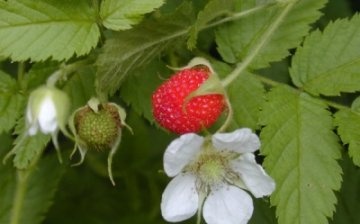
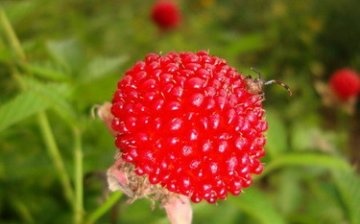
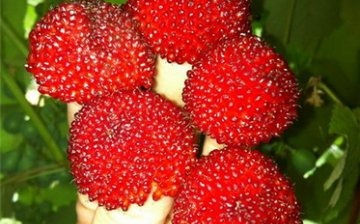




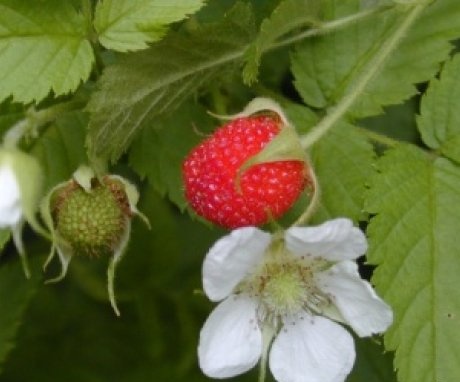
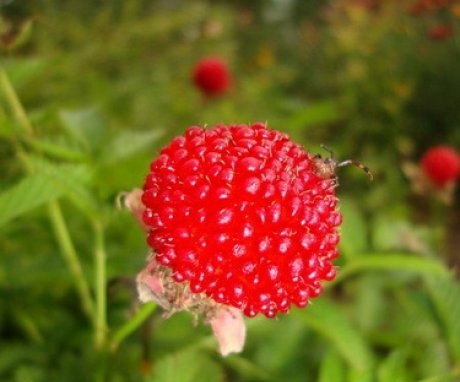
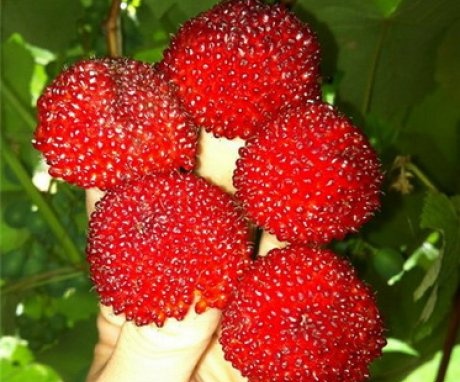
I have not yet met such a variety of raspberries, the shape of the berries is slightly different in it, which have a peculiar, pleasant taste. All the same care for the plant is about the same as for any other raspberry.
I looked closely at this raspberry, but did not take it. They were attracted by really large berries and the decorative nature of the plant. Confused by two points. Firstly, the taste, it seems to be neutral, in contrast to the tasty and aromatic "classic" raspberries. Second - there are thorns on the bush, they are small, but you will have to pick the berries carefully (like a blackberry).